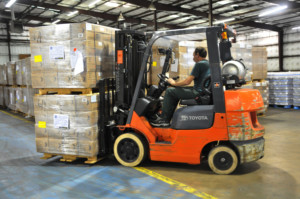 This is the last of my three posts on how to benefit at the cost of your successor. And again, please don’t. This is more of a warning on how to damage the plant for the benefit of the manager. And again, I hope rather than someone using this as a to-do list, someone uses it to see dangers. This last post looks at the worst “trick” of them all, burning the goodwill of your employees for a quick buck. It also looks at the one easiest to see, selling the plant and renting it back.
This is the last of my three posts on how to benefit at the cost of your successor. And again, please don’t. This is more of a warning on how to damage the plant for the benefit of the manager. And again, I hope rather than someone using this as a to-do list, someone uses it to see dangers. This last post looks at the worst “trick” of them all, burning the goodwill of your employees for a quick buck. It also looks at the one easiest to see, selling the plant and renting it back.
Employee Motivation
 Possibly the worst way to hurt a plant is to burn the goodwill of your employees for a quick buck. Let’s assume an optimistic case where your workforce in general is motivated and is in support of the plant and its management. Note that I said it is an optimistic case, not a realistic one, for most companies. If management asks for some extra effort, some “midnight oil,” or similar, employees may be willing to pitch in. However, the longer the manager expects his people to go above and beyond their duty, the less willing they are to do so. Morale goes down, and when a true emergency arises, the willingness of the employees to pitch in may be gone. I personally consider burning the goodwill of your people for a quick buck the worst of these shady practices, as a broken motivation is the one hardest to fix. Or, the manager promises a promotion/raise/perks/bonuses/home-office/etc., but the promise never materializes, and since it was not in writing, the employee has no legal approach to claim the perks. Yet another morale burnt for a quick buck.
Possibly the worst way to hurt a plant is to burn the goodwill of your employees for a quick buck. Let’s assume an optimistic case where your workforce in general is motivated and is in support of the plant and its management. Note that I said it is an optimistic case, not a realistic one, for most companies. If management asks for some extra effort, some “midnight oil,” or similar, employees may be willing to pitch in. However, the longer the manager expects his people to go above and beyond their duty, the less willing they are to do so. Morale goes down, and when a true emergency arises, the willingness of the employees to pitch in may be gone. I personally consider burning the goodwill of your people for a quick buck the worst of these shady practices, as a broken motivation is the one hardest to fix. Or, the manager promises a promotion/raise/perks/bonuses/home-office/etc., but the promise never materializes, and since it was not in writing, the employee has no legal approach to claim the perks. Yet another morale burnt for a quick buck.
 It seems, the USA as a whole is right now experiencing such a “great resignation” in the workforce, where employees are no longer willing to take the abuse that managers often still take for granted. Hopefully, it will change the USA for the better.
It seems, the USA as a whole is right now experiencing such a “great resignation” in the workforce, where employees are no longer willing to take the abuse that managers often still take for granted. Hopefully, it will change the USA for the better.
Also, please note that not all broken plant motivation is the result of such shady manipulation; it may also be the result simply of management errors, miscommunication, neglect, or, generally, a lack of respect.
Sell Your Plant and Rent It
 There may be another big expense, but this one may already be paid: the property your plant sits on and the machines inside. However, there is a (shady) way to get it back. Just sell your plant and your machines. But you need the plant and the machines to produce, you say? No problem, just rent it back from the new owners. You generate a huge incoming cash flow at the expense of a smaller recurring cost.
There may be another big expense, but this one may already be paid: the property your plant sits on and the machines inside. However, there is a (shady) way to get it back. Just sell your plant and your machines. But you need the plant and the machines to produce, you say? No problem, just rent it back from the new owners. You generate a huge incoming cash flow at the expense of a smaller recurring cost.
You hopefully already see the problem. In the long run, renting may be more expensive than owning. It also makes your plant vulnerable. What if the new owner does not want to extend your contract, but instead wants to rent or sell it to the competitor? Or have a housing project built on the property? Any change or improvement is also more difficult. Want to drill a hole here or remove a wall there? You need permission from the owner. Are you now liable if there’s contamination of the ground if the new owner wants to build an elementary school on the property? No matter what, there are now at least two legal parties (and their well-paid lawyers) that have to sort things out.
 As for the “positive cash flow,” there is another risk to shady managers. For the other entries in this series (maintenance, quality, service, research and development, and improvement), the savings can be well calculated by cost accounting. The future problems, however, can usually not be determined. What is the cost of unhappy customers? It is there, but it is hard to put a number to it. Yet, if cost accounting can’t calculate it, it simply assumes zero. Hence, for maintenance, quality, etc., you have a measurable savings, but an unknown and hence accounting-wise zero future cost.
As for the “positive cash flow,” there is another risk to shady managers. For the other entries in this series (maintenance, quality, service, research and development, and improvement), the savings can be well calculated by cost accounting. The future problems, however, can usually not be determined. What is the cost of unhappy customers? It is there, but it is hard to put a number to it. Yet, if cost accounting can’t calculate it, it simply assumes zero. Hence, for maintenance, quality, etc., you have a measurable savings, but an unknown and hence accounting-wise zero future cost.
Not so for selling your plant and renting it back. The future rent is well known, and cost calculation can determine the current cost of future recurring expenses. Hence, if someone does the math, they may actually find out that your “positive cash flow” for selling the plant is actually a negative cash flow if future costs are included. Let’s better hope nobody does the math, right?
Because of this – literal – accountability, selling and renting it back is not common. But it has happened. However, you find it more commonly with machines, not so much for selling them and renting them back (although this has also happened), but with renting them outright, forgoing the initial expense at the cost of a regular fee. Properties can also be rented if the company does not have the cash to buy. It may even make sense to rent property and machines instead of buying them if the cash flow is not available.
 Also very popular is to not rent a machine, but to pay a fee for the availability of a machine. Forklifts especially are often provided by an external service provider, and you pay only for the availability of a working forklift. This may even make sense, as the forklift provider benefits from an economy of scale, and it is easier and cheaper to manage and maintain a large fleet of forklifts than to have a person taking care of three forklifts on the side. Still, you should look at the numbers if renting or a service fee is truly the better option than buying.
Also very popular is to not rent a machine, but to pay a fee for the availability of a machine. Forklifts especially are often provided by an external service provider, and you pay only for the availability of a working forklift. This may even make sense, as the forklift provider benefits from an economy of scale, and it is easier and cheaper to manage and maintain a large fleet of forklifts than to have a person taking care of three forklifts on the side. Still, you should look at the numbers if renting or a service fee is truly the better option than buying.
Summary
 There are probably more such areas vulnerable to such shady approaches for managers to benefit at the cost of the future of the plant. Any place where someone can save money at the cost of future performance could be abused for such dirty tactics. Yet, it is often not easy to see for the next level management when it happens. There are many situations where it is quite possible to improve expenses for maintenance, quality, service, research and development, improvements, and training without damaging future performance. In all of these cases, the impact on the future performance is very hard to estimate. The only exception is when someone sells the plant and then rents it back, where you can calculate the future cost impact quite easily.
There are probably more such areas vulnerable to such shady approaches for managers to benefit at the cost of the future of the plant. Any place where someone can save money at the cost of future performance could be abused for such dirty tactics. Yet, it is often not easy to see for the next level management when it happens. There are many situations where it is quite possible to improve expenses for maintenance, quality, service, research and development, improvements, and training without damaging future performance. In all of these cases, the impact on the future performance is very hard to estimate. The only exception is when someone sells the plant and then rents it back, where you can calculate the future cost impact quite easily.
But for everything else you need a very good understanding of the system to estimate how a reduced service department, for example, will impact customer satisfaction and subsequently sales. Probably the people in the respective departments (maintenance, quality, service, and research and development) know best, but then they are also usually biased toward NOT reducing their department. Even more complicated: The resources of the plant are limited, and not every department can get the resources it wants to have, or maybe not even the ones it needs. This makes it hard to understand how much to allocate where.

Additionally, it is rare for a manager to make drastic cuts to these areas. It is more a death by a thousand cuts, reducing a little bit here, cutting a little bit there, and over multiple years and often multiple generations of managers, you end up with the situation that some of you, unfortunately, already have. The plant is “saved” into the ground. In German we even have a word for it: Kaputtgespart!
This happens not only in manufacturing. Just by listening to the news you can find many examples where someone avoids problems now at the cost of the future. For example, politics is a ripe topic for that, from how to finance future pensions (where the problem can be calculated well) to the quality of the school system (where the future impact is anyone’s guess).
This concludes the three-post series on a rather odd topic. I was hesitant to write about this, because I usually try to tell you how to do it. But sometimes there is also value in seeing how NOT to do it. Hence, I hope you enjoyed these three posts. Or, more likely, you winced at all the examples because you have seen someone do this. Anyway, now, go out, do the right thing, and organize your industry!

A lot of industries here in USA are finding out the hard way the cost of having a demotivated and demoralized workforce. It doesn’t help that companies like McDonalds and Amazon pioneered the business model where workers are a consumable wear item rather than an investment, kind of like oil in a car engine that gets replaced once a year or more often.
Sadly, by the time the problem becomes too obvious to ignore, it’s far too late to fix it when everyone that was any good has left the company and the only people left on the floor either don’t care anymore or too new to know much.
Healthcare and airlines in particular are finding out the hard way that replacing ground level staff is a lot more complicated than hiring new bodies at a local jack in the box.
The working culture in the USA is often broken. Workers are seen as replaceable machines, whereas in Europe the workplace is also a social entity. We have job security (it is hard to fire people), maternity leave, sick leave, unions, public healthcare, and many other things that are often sorely missing in the USA. It benefits the wealthy at the expense of the lower and middle class. Working conditions are usually much better in Europe.
“Workers are seen as replaceable machines”
I disagree. Machines are expensive, whereas workers are seen as a disposable wear item. That’s why I used the car engine and oil analogy. Repairing or replacing an engine completely is extremely expensive, while oil is relatively cheap and is meant to be drained and replaced regularly. 🙂
For what it’s worth, the pandemic has been a huge blessing for many american workers. It closed the borders to immigration and its horribly corrosive effect on wages and bargaining power. Some employers still haven’t got it, but many are beginning to accept that they can’t treat their employees worse than the Russian army treats its conscripts.
Yes, you are right. For some companies, a worker is more like a rental car. You get your fun out of it, and don’t care to abuse the engine or tires. After that, not your problem.
(Side note: I treat both my employees and my rental cars better than that!)